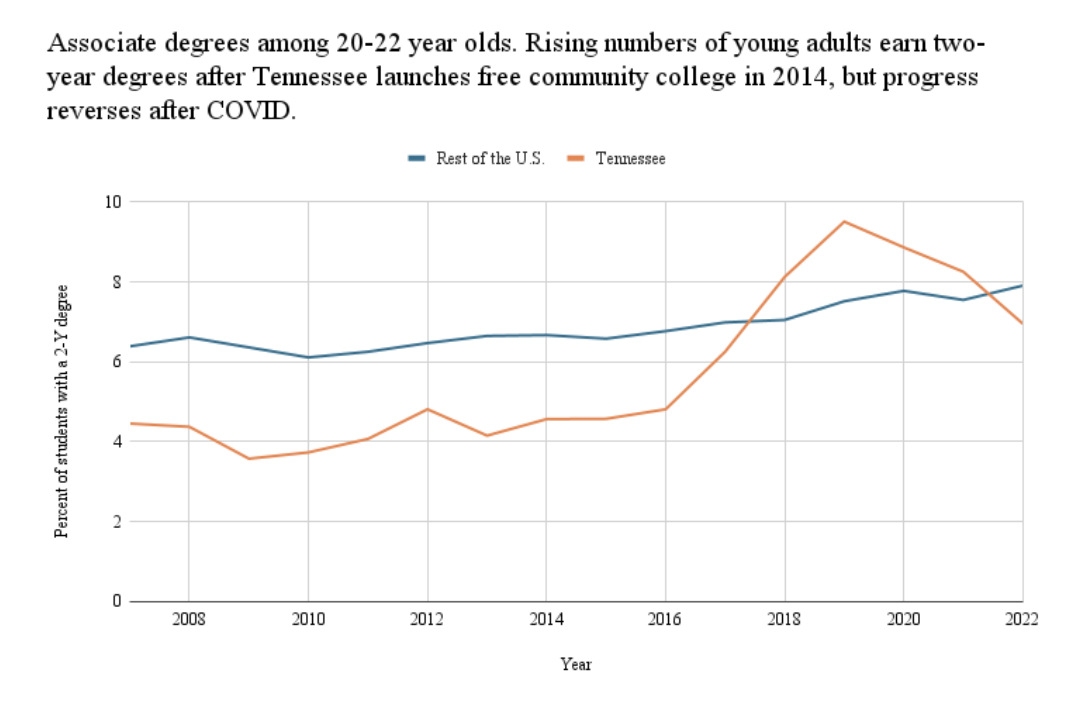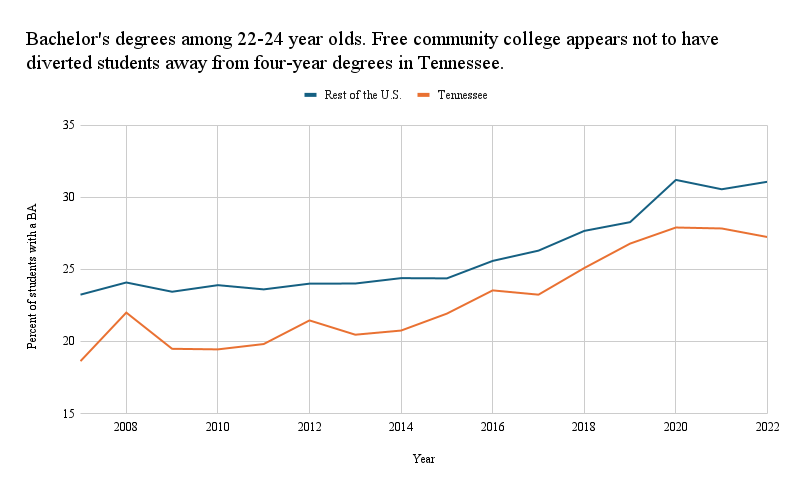This story about free community college was produced by The Hechinger Report, a national nonprofit newsroom that reports on one topic: education.
The free community college movement effectively began in 2014 when Republican Gov. Bill Haslam of Tennessee signed the Tennessee Promise Scholarship Act, which offered the state’s high school graduates free tuition to attend any two-year public community college or technical college in Tennessee.
Communities around the country had been experimenting with free college programs since 2005, usually with private funding, but Tennessee was the first to make it a statewide policy, and it inspired 36 states to follow suit. This year, Massachusetts was the most recent to make community college free.
[Related: A free search tool for all the free college programs.]
But as free-tuition programs have multiplied, so have questions and doubts. Are low-income students benefiting? Is free tuition leading to more college graduates?
Unfortunately we have to wait years to allow students time to get through college, but answers to these important questions are starting to emerge from Tennessee. College Promise, a nonprofit that advocates for making college free, along with tnAchieves, the nonprofit that helps administer the Tennessee program, released a 10-year anniversary report on Oct. 14. The report offers encouraging signs that the Tennessee Promise scholarship program, which now costs about $29 million a year in tuition subsidies and other services, has helped more students go to college and earn two-year associate degrees. In addition, Tennessee shared some of the lessons learned.
First the numbers. The report highlights that more than 90 percent of all Tennessee high school seniors apply for the free college program.
All students regardless of family income are eligible.
Roughly 15,000 students a year ultimately use the program to enroll in college right after high school. About half come from low-income families who qualify for the Federal Pell Grant.
Thirty-seven percent of students who initially enrolled in college with the Promise scholarship program earned a two-year associate degree within three years, compared with only 11 percent of students who applied for the scholarship but never met its requirements, such as financial aid paperwork and service hours.* Tennessee projects that since its inception, the scholarship program will have produced a total of 50,000 college graduates by 2025, administrators told me in an interview.
Before the free tuition program went statewide, only 16 percent of Tennessee students who started community college in 2011 had earned an associate degree three years later. Graduation rates then rose to 22 percent for students who started community college in 2014. At this time, 27 Tennessee counties had launched their own free tuition programs, but the statewide policy had not yet gone into effect.
By 2020, when free tuition statewide had been in effect for five years, 28 percent of Tennessee’s community college students had earned a degree in three years. Not all of these students participated in the free tuition program, but many did.
[Related: States bet big on career education but struggle to show it works]
It’s unclear if the free tuition program is the driving force behind the rising graduation rates. It could be that motivated students sign up for it and abide by the rules of the scholarship program and might have still graduated in higher numbers without it. It could also be that unrelated nationwide reforms, from increases in federal financial aid to academic advising, have helped more students make it to the finish line.
I talked with Celeste Carruthers, an economist at University of Tennessee Knoxville, who has been studying the free tuition program in her state. She is currently crunching the numbers to figure out whether the program is causing graduation rates to climb, but the signs she sees right now are giving her “cause for optimism.” Using U.S. Census data, she compared Tennessee’s college attainment rates with the rest of the United States. In the years immediately following the statewide scholarship program, beginning with the high school class of 2015, there is a striking jump in the share of young adults with associate degrees a few years later, while associate degree attainment elsewhere in the nation improved only mildly. Tennessee quickly went from being a laggard in young adult college attainment to a leader – at least until the pandemic hit. (See graph.)

Source: College Promise
Thirty-seven states operate statewide free college tuition programs. Some programs cover all tuition and fees; others don’t. Some just cover two-year community colleges while others include four-year institutions. Some only give assistance to low-income students; others give aid only to students who meet certain academic thresholds. Some states offer free tuition to a combination of those with need and merit.
While evaluation of the Tennessee program continues, researchers and program officers point to three lessons learned so far:
- The scholarship program hasn’t helped many low-income students financially. The Federal Pell Grant of $7,395 far exceeds annual tuition and fees at Tennessee’s community colleges, which hover around $4,500 for a full-time student. Community college was already free for low-income students, who represent roughly half of the students in Tennessee’s free college program. Like other free college programs around the country, Tennessee’s is structured as a “last dollar” program, which means that it only pays out after other forms of financial aid are exhausted.
That means that tuition subsidies have primarily gone to students from higher income families that don’t qualify for the Pell Grant. In Tennessee, the funding source is the state lottery. Roughly $22 million of lottery proceeds were used to pay for community college tuition in the most recent year.
- Free tuition alone isn’t enough help. In 2018, Tennessee added coaching for low-income students to give them extra support. (Low-income students hadn’t been receiving any tuition subsidies because other financial aid sources already covered their tuition.) Then, in 2022, Tennessee added emergency grants for books and other living expenses for needy students – up to $1,000 per student per semester.* The extra assistance for low-income students is financed through state budget allocations and private fundraising. For students who are the first generation in their families to attend college, current graduation rates have jumped to 34 percent with this extra support compared with 11 percent without it, the 10-year report said.
“Pairing the financial support with the non-financial support – that mentoring support, the coaching support – is really the sweet spot,” said Graham Thomas, chief community and government relations officer at tnAchieves. “It’s the game changer, and that is often overlooked for the money part.”
Coaching is best conducted in person on campus. During COVID, Tennessee launched an online mentoring platform, but students didn’t engage with it. “We learned our lesson that in-person is the most valuable way to go when building relationships,” said Ben Sterling, chief content officer at tnAchieves.
- The worst case scenario didn’t happen. When free community college was first announced, critics fretted that the zero price tag would lure students away from four-year colleges, which aren’t free. That’s bad because the transfer process from community college back to a four-year school can be rocky with students losing credits and the time invested. Studies have shown that most students are more likely to complete a four-year degree if they start at a four-year institution. But the number of bachelor’s degrees did not fall. It seems possible that the free tuition policy lured students who wouldn’t have gone to college at all in the past, without cannibalizing four-year colleges. However, bachelor’s degree acquisition in Tennessee, though rising, remains far below the rest of the nation. (See graph.)

Graph by Jill Barshay/The Hechinger Report.
Computations by Celeste Carruthers, University of Tennessee Knoxville. Data Source: American Community Survey, via IPUMS (https://usa.ipums.org/usa/index.shtml).
As an aside, students are also able to use their Tennessee Promise scholarship funds at a limited number of public four-year colleges that offer associate degrees. About 10 percent of the program’s students take advantage of this option.
[Related: Colleges are now closing at a pace of one a week. What happens to the students?]
Despite all the positive signs for educational attainment in Tennessee, recent years have not been kind. “Everything that’s happened to enrollment since COVID kind of erased all of the gains from Tennessee Promise,” said the University of Tennessee’s Carruthers. The combination of pandemic disruptions, a strong job market and changing public sentiment about higher education hammered enrollment at community colleges nationwide. Students have started returning again in Tennessee, but community college enrollment is still below what it was in 2019.
***
This story about free community college was written by Jill Barshay. She writes the weekly “Proof Points” column about education research and data, covering a range of topics from early childhood to higher education. She taught algebra to ninth-graders for the 2013-14 school year. Previously, Barshay was the New York bureau chief for Marketplace, a national business show on public radio stations. She has also written for Congressional Quarterly, The Wall Street Journal, The New York Times and the Financial Times, and appeared on CNN and ABC News.
The Hechinger Report, is a nonprofit, independent news organization focused on inequality and innovation in education. The Hechinger Report provides in-depth, fact-based, unbiased reporting on education that is free to all readers, keeping educators and the public informed about pressing issues at schools and on campuses throughout the country. Sign up for Proof Points and other Hechinger newsletters.




























